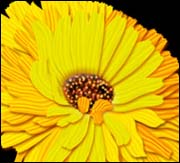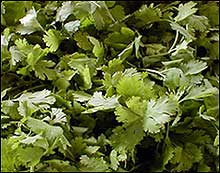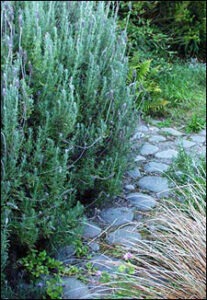|
Hardy annual Cosmetic, Culinary, Medicinal, Ornamental 1 to 1-1/2 feet high, 1 foot wide Full sun Rich, well-drained soil |
Calendula, Pot Marigold, Calendula officinalisAs cooler weather approaches in the fall and many herbs stop flowering, calendula is a special plant to have in the garden. Plants have long been cherished for the long periods of color they add late in the season, the flavor they add as a seasoning, and the relief they provide as medicine.
Calendulas originated in India where the Hindus used them to decorate their temple altars. It takes its botanical name from the Latin word calendae, which means “throughout the month,” referring to its long bloom season. |
Flowers are single or double, and definitely live up to their name, “flowers in the sun.” They close up at night and occasionally on dark days, then reopen with sunshine. Flowers are borne on top of sturdy stems, framed by large, oblong, pale green, aromatic leaves. This herb’s neat growth and cheerful color make it a lovely indoor container plant.
Planting & Care.
Easy to grow from seed. Sow in light, well-drained rich soil in a sunny location in spring. For fall bloom, sow in early summer. These hardy annuals reseed freely. With the right conditions new plants come up year after year. To encourage new blooms on existing plants, pick and enjoy flowers frequently.
Harvesting and Use.
Flower petals have many medicinal and cosmetic values. They are an excellent source of vitamin A and phosphorus. Drinking an infusion of the petals has been recommended to help poor circulation and varicose veins. Use it for bathing to relieve tired swollen feet, for cleansing and softening skin, and for soothing tired eyes. An ointment made from the petals can treat acne, relieve sunburn and minor burns, and can help fade old scars.
Culinary Use.
Petals give food a delicate, tart flavor, which some claim is similar to tarragon. Chopped blooms impart a strong color to eggs, cheeses and soups, and can be used as an inexpensive substitute for saffron in rice and pasta dishes, biscuits and breads. The petals make a colorful and nutritious addition to salads. To experience this edible flower, try the recipe for Calendula Vinaigrette.



